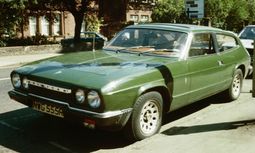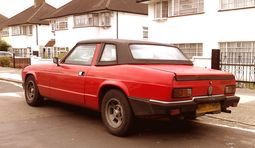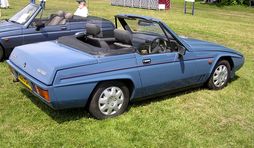The History Of Reliant Scimitar Sabre

Reliant Scimitar is a model name used by British manufacturer Reliant for several models of sports car.
Reliant's first Scimitar was a coupé based upon the styling of a Daimler SP250 prototype (renamed the SX250) and the chassis of a Reliant Sabre. It was first displayed in 1964. It was powered by a 2.6L Ford straight six from the Ford Zephyr / Ford Zodiac.
In 1966 the SE4A was replaced by the SE4B, with a V6 3.0L Ford "Essex" engine. The cheaper SE4C came with a 2.5L version of the same engine. Just over 1000 SE4s were produced.
Based on the chassis of the earlier coupé and the Ogle Design GTS estate car experiment, the four-seater Scimitar GTE SE5 came with either a 2.5L or 3.0L engine. The 3.0L engine, which gave this model a top speed of over 120mph (193km/ h), was more popular, and the 2.5L version was later dropped. A Borg-Warner automatic transmission was added as an option in 1970 and by 1971, overdrive on the 4-speed manual was offered. In 1972 several improvements were included in the upgrade to SE5A, including a boost in power. The extra 7hp (5kW) and maximum engine speed raised performance quite a bit and the GTE was now capable of 0-60mph (100km/ h) in 9.3seconds and top speed was raised by 6mph (10km/ h). The SE5's flat dashboard also gave way to a lower quality[citation needed] curved and moulded plastic one.
Less than 2500 SE5s were produced. The 5A model sold more than any other Scimitar, with approximately 6630 manufactured.
More of a luxury model than the SE5, the SE6 series was promoted to the executive market. These models were two-door sports estates, again with the Ford V6 3.0L engine, and were a few inches longer and wider than their predecessor. The SE6 had some quality issues and was soon replaced by the SE6A. About 550 SE6 models were produced.
The SE6A displayed a number of improvements, including better quality brakes and road-holding. There was also the option of power steering. 3908 SE6As were made.
Ford had stopped making the "Essex" engine by 1979, so one of the major differences with the SE6B was the engine choice. The Ford "Cologne" 2.8L V6 was used instead, and provided similar power but rather less torque. The final drive ratio was changed to compensate.
Only 407 production SE6Bs were manufactured. Production ceased by 1986.
The convertible version of the Scimitar GTE was known as the Scimitar GTC, or SE8B. When the hood (top) was folded down a fixed rollover bar was left in place over the car mounted just behind the doors. It was modelled closely on the SE6B and still included four seats and the 2.8L "Cologne" engine.
Only 442 production GTCs were manufactured.
Aiming to fill a gap in the small sports car market, the Michelotti-designed Scimitar SS1 was launched in 1984. The chassis was inspired by Lotus's Elan. 1300cc and 1600cc Ford engines were used, at first, later replaced with a 1400cc CVH Ford engine and a Nissan 1800cc turbocharged engine. The front mounted engine drives the rear wheels through a five speed gearbox on all models except the 1300 which uses a four speed transmission. The suspension is independent all round using coil springs with semi trailing arms at the rear. The body panels are made of polyurethane or glass reinforced polyester and are fitted to a space frame backbone chassis. the panels were designed to be easily removed and replaced to repair accident damage. A removable hard top was available.
This car had unusual uncovered Porsche 928 style pop-up headlights and shared many components with production cars of the day. It is currently one of the most affordable small sports convertibles on the second hand market. The post 1986 (galvanised chassis) (identified by a single windscreen wiper) models are particularly sought after, but rarely fetch over £2000.
The Scimitar SS2 concept car was based on the SS1 1800ti, restyled by William Towns. Intended for the United States market and powered by a V8 engine, it was commissioned by General Motors, but planned production of the car was dropped when GM funding was withdrawn.
Some of the styling features of the SS2 prototype were incorporated into a facelifted SS1 model, renamed Scimitar SST ("T" for "Towns"). The SST was launched in 1990.
The Scimitar Sabre was the last Scimitar model to be produced. Based on the chassis of the SS1 and SST, it was announced in 1991 and launched in 1992, with a restyle in 1993. The Rover K-series 1.4L engine made this the second fastest Reliant ever, with only the 1800Ti being quicker. Production finished in May 1995 when Reliant was taken over.
After production at Reliant ceased, Middlebridge Scimitar Ltd. acquired the manufacturing rights to the Scimitar GTE and GTC in June 1987. This company, based in Nottingham, produced a 2.9L version of the GTE with many modifications and modernizations including fuel injection and a 5-speed gearbox.
Only 77 Scimitars were ever produced by Middlebridge before the company went into receivership in 1990. The production rights were subsequently acquired by Graham Walker Ltd., who builds Scimitars to order.
From Wikipedia, the free encyclopedia
More About Reliant Scimitar Sabre




|